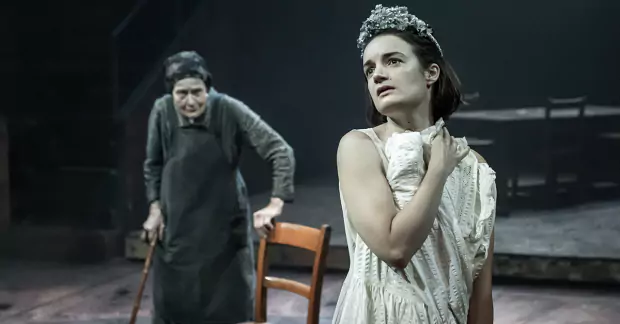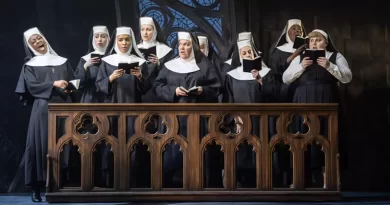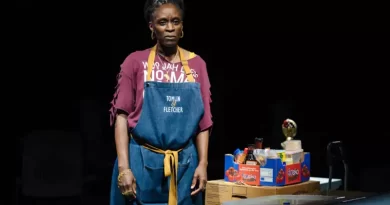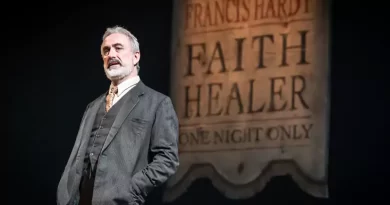“Blood Wedding”, Young Vic
Jeremy Malies on the South Bank
26 September 2019
Yaël Farber is on record as saying that: “Directing is asking people to run full speed into a wall with you.” If I had been part of the outstanding ensemble and creative team that Farber assembled at the Young Vic for a transformative production of Lorca’s Blood Wedding I would have hung back and avoided commitment to a project that lurches between brilliance and the archly self-conscious.
It’s hardly a quantum leap to note that Lorca’s native southern Spain with its family feuds, agrarian communities and Catholicism sitting uneasily above older pagan traditions has many parallels with Ireland. The similarities have prompted adaptor Marina Carr to serve up a version of the play set in “Andalusia, County Offaly”. A largely Irish cast speak Hiberno-English with their Irish accents but while playing Moon, Thalissa Teixeira (wearing a gleaming white trouser suit) sings a cappella in Spanish while elsewhere there is use of flamenco guitar. All this, ostensibly in the province of Leinster, was difficult to swallow if you had not bought in fully. However elemental the magic realism characters might be, I found Farber’s implicit suggestion that folk tradition across Europe is homogeneous both patronizing and lazy.
Entering the Young Vic (configured more or less in the round) we see a small pool of blood on the stage. Susan Hilferty’s spare minimalist set with battered panelling conveys a sense of foreboding and leaves you in little doubt that matters will end in a bloodbath. It’s a rare splash of colour; the palette is predominantly inky and monochrome suggesting that these people might be daguerreotypes. Hilferty artfully contrives for a wall to swivel over to become the floor of an extra room and her design alternates between earthy everyday and an otherworldliness.
There are many stand-out performances and the quality of acting far outstrips the overall concept and artistic endeavour with its indeterminate backdrop, clunky metaphors and Farber’s unclear vision. As the Groom’s ferocious vengeful Mother, Olwen Fouéré is rough-hewn and flinty as though her face has been carved out of Mount Rushmore. The victim of patriarchy herself, she sees her daughter-in-law (Aoife Duffin known only as ‘Bride’) in terms of a chattel, leading to one of the many laugh-out-loud moments as she tries to inspect Duffin’s teeth on the morning of the wedding: “I’m not a heffer at the mart.” There is occasional inspired black comedy that leavens the evening.
Duffin impresses as her character finally throws off the sullen intensity of a thwarted teenager with the realization that not only is she a pawn in a far broader factionalist battle but the ardour of her lover Leonardo has waned the moment that he wins her, and the attraction all along might have been that she was unattainable. Duffin manages to convey all this despite the laboured efforts of movement director Imogen Knight who has the eloping pair in a harness that suggests flight on horseback but with nowhere near the visual impact you would expect after the elaborate process of hooking them up. This may have been improved since press night.
Music is by Isobel Waller-Bridge – yes, sister of Phoebe. It’s ethereal, appropriately austere, elegiac when characters reflect on death, and the tempi precisely echo the pulse of the plot. Waller-Bridge is another member of the team who might justifiably wonder why their contribution has not seen the undertaking add up to the sum of its wonderful parts. There are also some woeful bodice-ripping love scenes which, if there were one, I would put forward for the theatrical equivalent of the annual Bad Sex in Fiction Award.
At a dour and sometimes funereal 110 minutes you felt that the oldest and most drink-befuddled wedding guest could catch up with the fleeing couple. One of the few consistent merits is a vivid representation of the codified sense of mourning and loss that pervade all of Lorca’s plays together with a connection with the land. The symbolism is also there but the lyricism and melody are missing and Carr’s linguistic devices (some might be tongue-in-cheek) are often overwrought. Lorca was versed in many stage cultures and not overly protective of his work. He would probably see this project as a bold but flawed experiment. The play will be revived in more traditional forms or given a radical rework but in a less mannered style. It is robust with a reputation that will always attract audiences.









